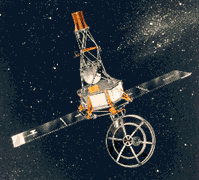Mariner 1, 2
Part of the Mariner program
 Mariner 2 was the world's first successful interplanetary spacecraft. It became the first spacecraft to flyby another planet on December 14, 1962 when it passed within 34,833 kilometers from the surface of Venus. During its flyby, Mariner 2 measured the temperatures of the clouds and surface of Venus as well as fields and particles near the planet and in interplanetary space. It discovered that Venus lacks a strong magnetic field and radiation belts, and that Venus' surface temperature was over 400 deg C. Contact was lost January 3, 1963 when the spacecraft was 86.9 million kilometers from Earth. An identical sister vehicle, Mariner 1, was lost in a launch failure prior to the launch of Mariner 2.
Mariner 2 was the world's first successful interplanetary spacecraft. It became the first spacecraft to flyby another planet on December 14, 1962 when it passed within 34,833 kilometers from the surface of Venus. During its flyby, Mariner 2 measured the temperatures of the clouds and surface of Venus as well as fields and particles near the planet and in interplanetary space. It discovered that Venus lacks a strong magnetic field and radiation belts, and that Venus' surface temperature was over 400 deg C. Contact was lost January 3, 1963 when the spacecraft was 86.9 million kilometers from Earth. An identical sister vehicle, Mariner 1, was lost in a launch failure prior to the launch of Mariner 2.
Spacecraft
Based on Ranger lunar spacecraft. Octagonal bus structure. Power provided by two deployed solar panels. 3-axis stabilized using cold gas jets. S-Band communications using LGA or HGA. Hydrazine main engine.
Payload
Geiger tubes, ion chamber, cosmic dust detector, microwave radiometer, magnetometers.
| Country of Origin | United States |
| Customer/User | NASA |
| Manufacturer(s) | JPL |
| Orbit | Solar orbit - Direct trajectory, Venus flyby on December 12, 1962 |
| Related Sites | JPL Mariner 2 Summary |
Launch Facts
| Name | Int'l Desig. | Date | Site | Vehicle | Orbit | Mass(kg) |
| Notes | ||||||
| Mariner 1 | none | 7/22/62 | ESMC | Atlas Agena B | FTO | 200 |
| Destroyed by range safety; Venus probe | ||||||
| Mariner 2 | 1962-A[Rho]1 | 8/27/62 | ESMC | Atlas Agena B | Solar | 201 |
| Venus flyby at 34745 km | ||||||
Information in The Mission and Spacecraft Library is provided without warranty or guarantee. USE AT YOUR OWN RISK.